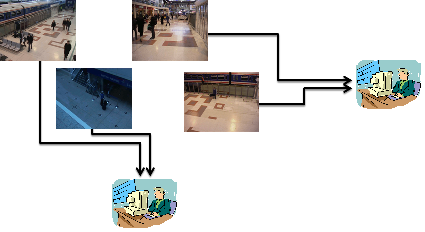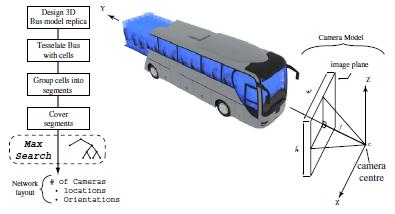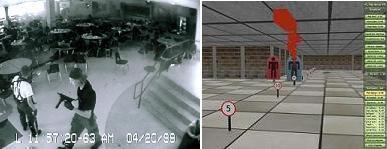Hey, Can You All Look Here?
Bias-aware Gaze Uniformity Detection and Correction in Group Images
Key Contributors: Omkar Kulkarni and Pradeep K. Atrey
PROBLEM:
Do you capture photos in group settings? => Yes!
Are there multiple individuals taking pictures of the group? => Often!
Do all members of the group face the same camera or gaze in the same direction? => Aahhh... No!
SOLUTION:
Don't worry, we have GARGI for you!
Multimedia Surveillance and Monitoring
Adaptive workload equalization in multi-camera surveillance systems (Collaborators: Mukesh Saini, Xiangyu Wang and Mohan Kankanhalli)

Surveillance and monitoring systems generally employ large number of cameras to capture people's activities in the environment. These activities are analyzed by hosts (human operators and/or computers) for threat detection. In order to meet the real-time requirements of surveillance, it is necessary to distribute the video processing load over multiple hosts. In general, cameras are statically assigned to the hosts; we show that this is not a desirable solution as the workload for a particular camera may vary over time depending on the number of the targets in its view. In the future, this uneven distribution of workload will become more critical as the sensing infrastructures are being deployed on the cloud. In this work, we model the camera workload as a function of the number of targets, and use that to dynamically assign video feeds to the hosts. Experimental results show that the proposed model successfully captures the variability of the workload, and that the dynamic workload assignment provides better results than a static assignment.
Bus surveillance: How many and where cameras should be placed (Collaborator: Khaled Amriki)

This camera placement in a bus is often performed manually based on human intuition and knowledge; however, there is no scientific basis to justify: (1) how many cameras would be sufficient, and (2) where (location) and how (with what orientation) they should be placed, to increase the area of coverage at the minimum cost. This research addresses this issue by breaking it down into two separate problems: MaxGain and MinCost. The MaxGain problem is aimed to maximize the overall coverage with a specific number of cameras; while the MinCost problem attempts to minimize the number of cameras to cover a specified area in the bus. The solutions to these two problems are presented. The proposed method computes the approximate coverage of a camera inside the 3D bus model. Furthermore, in order to improve the efficiency of the solution, an algorithm called "SmartMax" is proposed. The proposed solution advises precise locations and orientations (pan and tilt angles) of required cameras and can be used to validate the current camera installations in various types of public transit buses. The video demo is available here.
Modeling, simulation and analysis of a weaponry-equipped camera surveillance system (Collaborator: Robert Bisewski)
 In current video surveillance systems, camera views are monitored via remote security personnel. If a serious incident such as gun shooting occurs, it can take time for security to arrive at the scene. During this time, the assailant(s) may cause considerable damage and endanger many lives. Ergo, this research investigates feasible disabling devices that can be augmented with camera systems to disable the assiliant(s) and minimize the loss of lives of innocent citizens. For more details, click here.
In current video surveillance systems, camera views are monitored via remote security personnel. If a serious incident such as gun shooting occurs, it can take time for security to arrive at the scene. During this time, the assailant(s) may cause considerable damage and endanger many lives. Ergo, this research investigates feasible disabling devices that can be augmented with camera systems to disable the assiliant(s) and minimize the loss of lives of innocent citizens. For more details, click here.
Privacy issues in multimedia surveillance (Collaborators: Mukesh Saini, Sharad Mehrotra amd Mohan Kankanhalli)
W3-Privacy: Understanding what, when, and where inference channels in multi-camera surveillance video
Privacy aware publication of surveillance video
Adaptive transformation for robust privacy protection in video surveillance
 |
Be alert, somebody is running and shouting in the corridor..., hmmm... How to assimilate the information from
multiple heterogeneous sensors in order to detect such events?
For more details, please see:
Information assimilation for event detection (Collaborators: Mohan Kankanhalli, Ramesh Jain, John Oommen, and Namunu Maddage).
|
 |
Where to place the sensors for effective surveillance...?
For more details, please see: Optimal Sensor Placement (Collaborators: Mohan Kankanhalli, G. Shivaram, Vivek K. Singh and K R Ramakrishnan).
|
 |
Who has left this item in the hallway...? This might be dangerous... How can sensors actively compete and cooperate with each other to detect the abandoned object, identify the person and his/her movement?
For more details, please see:
Active Coopetitive Sensing and Coopetitive Multimedia Surveillance. (Collaborators: Mohan Kankanhalli and Vivek K. Singh).
|
 |
Be careful... a sleepwalker is walking out of the house during sleep... system should alert the caretaker.
For more details: Sleepwalker Monitoring (Collaborators: Abed El Saddik and Md. Anwar Hossain).
|
Last updated: July 26, 2024.



 In current video surveillance systems, camera views are monitored via remote security personnel. If a serious incident such as gun shooting occurs, it can take time for security to arrive at the scene. During this time, the assailant(s) may cause considerable damage and endanger many lives. Ergo, this research investigates feasible disabling devices that can be augmented with camera systems to disable the assiliant(s) and minimize the loss of lives of innocent citizens. For more details, click
In current video surveillance systems, camera views are monitored via remote security personnel. If a serious incident such as gun shooting occurs, it can take time for security to arrive at the scene. During this time, the assailant(s) may cause considerable damage and endanger many lives. Ergo, this research investigates feasible disabling devices that can be augmented with camera systems to disable the assiliant(s) and minimize the loss of lives of innocent citizens. For more details, click